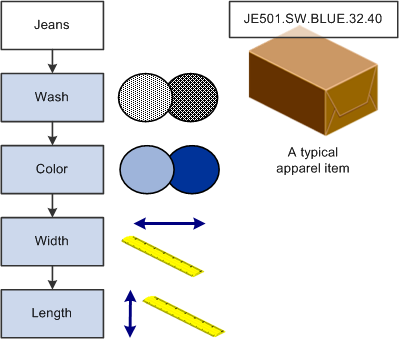Understanding Level Types
Level types refer to the actual levels or attributes associated with a particular style item. You can define up to 10 levels for an item. The first level, style item root level 0, defines the basic style of the item. The levels make up the hierarchy of the style item. Color, wash, width, and length are all examples of level types. Use the Item Level Type program (PCW011) to define level types. The system stores the level type information in the Item Level Type table (FCW011).
This diagram illustrates a style item with multiple levels. The style item root level 0 is Jeans.

When you define a level type, you specify whether the valid values for the level will be provided by a size matrix grid (grid code) or a UDC. For levels that use a grid code (for example, waist size and leg length), you must associate them with a category code field from the Item Master. The category code field holds the grid code value. For levels that use UDCs (for example, type of wash and color), you must define the UDCs appropriately.
All of the level types used for a particular item are grouped together in the item structure. The values for the levels are then used to create the style items. In the previous diagram, the item structure consists of style item root level 0, Jeans, followed by levels for wash, color, width, and length. When you create the style item, the values for each of these levels are included as part of the item name, which would be JE501.SW.BLUE.32.40 in this example. In this item name example, SW indicates that the wash is stone-washed, BLUE is the color of the jeans, 32 is the value for the width, and 40 is the value for the length. You also define how these levels are reflected in the creation and naming of the child style items.